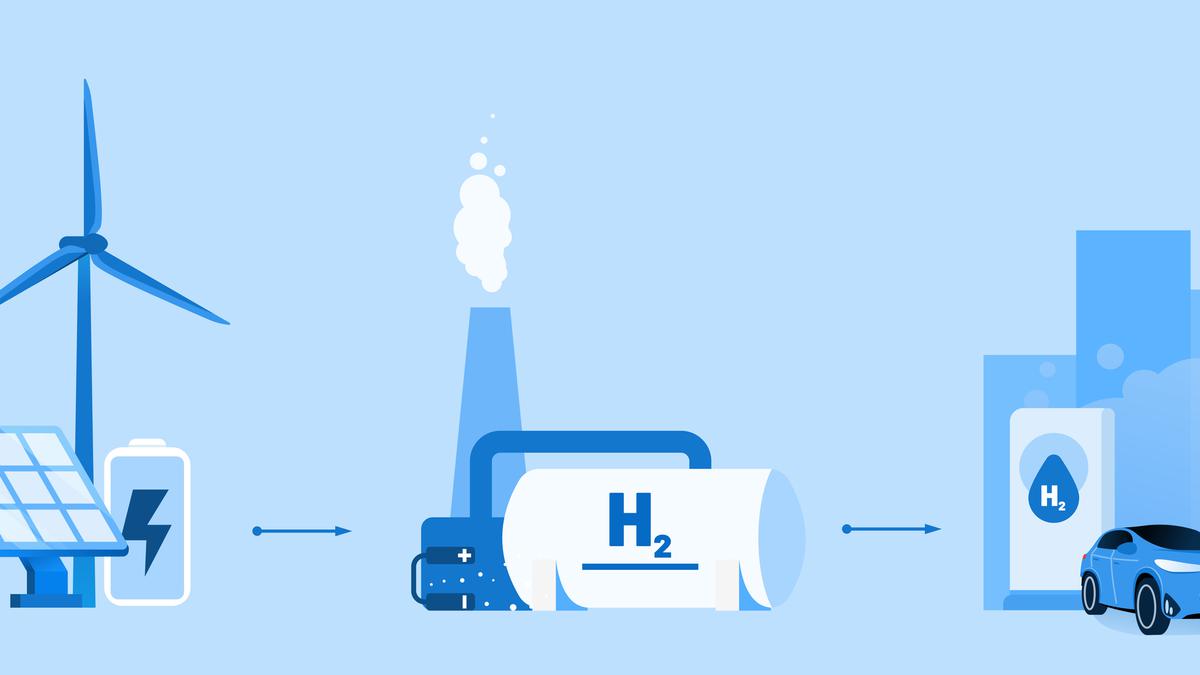Live Classes

The Union Cabinet on Wednesday approved a ?19,744 crore National Green Hydrogen mission that aims to make India a ‘global hub’ for using, producing and exporting green hydrogen.
The Union Cabinet has cleared a ?17,490-crore National Green Hydrogen (NGH) mission that aims to facilitate the production of hydrogen from renewable energy. Hydrogen is an essential industrial fuel that has a range of uses from producing ammonia, making steel and cement, to powering fuel cells that can run buses and cars. However, the cheapest way to manufacture this is to rely on fossil fuel such as coal and natural gas and this produces carbon emissions. The concerns over global warming and the gradual but steady embrace of alternative fuels have stoked the world’s interest in producing hydrogen from renewable energy sources such as solar and wind energy.
Hydrogen is a key industrial fuel that has a variety of applications including the production of ammonia (a key fertilizer), steel, refineries and electricity. However, all of the hydrogen manufactured now is the so-called ‘black or brown’ hydrogen produced from coal. Grey hydrogen is produced from natural gas while ‘Blue’ hydrogen is from fossil fuel sources where the ensuring carbon emitted is captured via carbon-capture processes. Green hydrogen is when hydrogen is produced via electrolysis, the splitting of water into hydrogen and oxygen with electricity generated from renewable energy sources such as solar or wind and its byproduct water, water vapor. This is the most environmentally sustainable way of producing hydrogen.
What is the caveat?
Green hydrogen currently accounts for less than 1% of global hydrogen production due to it being expensive to produce. A kilogram of black hydrogen costs $0.9-1.5 to produce while grey hydrogen costs $1.7-2.3 and blue hydrogen can cost anywhere from $1.3-3.6. However, green hydrogen costs $3.5-5.5 per kg, according to a 2020 analysis by the Council for Energy, Environment and Water.
What is the National Green Hydrogen Mission?
The intent of the mission is to incentivise the commercial production of green hydrogen and make India a net exporter of the fuel. The mission has laid out a target to develop green hydrogen production capacity of at least 5 MMT (Million Metric Tonne) per annum. This is alongside adding renewable energy capacity of about 125 GW (gigawatt) in the country. This will entail the decarbonisation of the industrial, mobility and energy sectors; reducing dependence on imported fossil fuels and feedstock; developing indigenous manufacturing capabilities; creating employment opportunities; and developing new technologies such as efficient fuel cells.
By 2030, the Centre hopes its investments will bring in investments worth ?8 trillion and create over six lakh jobs. Moreover, about 50 MMT per annum of CO2 emissions are expected to be averted by 2030. As per its Nationally Determined Contribution (NDC) to meeting the goals of the Paris Agreement, India has committed to reduce emissions intensity of its GDP by 45% by 2030, from 2005 levels.
How will the mission support green hydrogen production?
The Mission will “facilitate demand creation, production, utilisation and export of Green Hydrogen,” says a press release from the Ministry for New and Renewable Energy. There are two umbrella sub-missions under the programme. The first is the Strategic Interventions for Green Hydrogen Transition Programme (SIGHT), that will fund the domestic manufacturing of electrolysers and produce green hydrogen. The second is to support pilot projects in emerging end-use sectors and production pathways. States and regions capable of supporting large scale production and/or utilisation of hydrogen will be identified and developed as Green Hydrogen Hubs. According to the Ministry, ?17,490 crore would be for the SIGHT programme, ?1,466 crore for pilot projects and hydrogen hubs, ?400 crore for research and development and ?388 crore for other parts of the mission.
What are the challenges ahead?
Several major industrial houses have announced plans to facilitate India’s adoption of green hydrogen. However, they are all premised on India being able to access a reliable stream of components, upgrading the manufacturing and skill levels of its small and medium manufacturing enterprises and developing a transmission network that can supply the hydrogen produced from supply-spots to industrial centres across the country. Many advanced economies have also announced plans and policies to develop such an economy and given their advanced industrial infrastructure, can steal a march over India.
Green hydrogen development is still in the nascent stages globally and while India can take the lead in being a major producer, it doesn’t have the necessary infrastructure yet to execute all these intermediary steps. It also needs to announce incentives to convince enough users of industrial hydrogen to adopt green hydrogen. It needs to develop supply chains in the form of pipelines, tankers, intermediate storage and last leg distribution networks as well as put in place an effective skill development programme to ensure that lakhs of workers can be suitably trained to adapt to a viable green hydrogen economy.
Hydrogen:
The future of hydrogen
Hydrogen can be used to power vehicles, generate electricity, power the industry, and heat our homes and businesses. It could make a huge difference in our carbon emissions and will be critical to achieving net zero.
Why is hydrogen important as a future clean energy source?
Is hydrogen already being used as a fuel?
Hydrogen as an alternative green fuel in India and other countries?